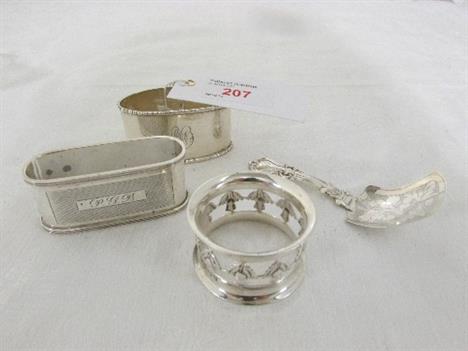An oak quarter chiming mantel clock, finely foliate scroll engraved gilt dial, signed on a silvered plaque in the centre `Elliot, 5 Percival St, Goswell Road, E.C.`, the shallow arch with three subsidiaries for chime/silent, slow/fast and Eight bell/Westminster, the massive English three-train movement with spotted backplate, chiming on eight bells and four gongs, in a case with bands of carved foliage and swags to the caddy top, 21in (54cm) high.
We found 81455 price guide item(s) matching your search
There are 81455 lots that match your search criteria. Subscribe now to get instant access to the full price guide service.
Click here to subscribe- List
- Grid
-
81455 item(s)/page
An oak 30 hour longcase clock, the 11 inch brass dial with rococo spandrels and silvered chapter ring, signed in the centre Rich. Gilkes, Devizes amongst engraved foliage and a bird, large calendar sector, four pillar movement in a plain case, flat hood with caddy top and blind fret, 77in (196cm) high.
Christopher Gould. An early 18th century month duration burr walnut longcase clock, the 12 inch brass dial signed below the silvered chapter ring Chr. Gould, Londini Fecit, the matted centre with subsidiary seconds and date aperture, ringed winding holes and engraved rosette to centre, mask and scroll spandrels divided by engraved foliage, the six ringed pillar movement with locking plate striking and anchor escapement, in a case of warm colour, the flat hood with caddy top and frets, finial blocks to the sides (finials lacking), the sides and plinth with herringbone inlays and crossbanded panels, 88in (223cm) high. Christopher Gould. Free of the Clockmakers Company 1682. Died 1718. A maker of great repute, especially of longcase clocks.
A Victorian cased set of six coffee spoons with gilt bowls and apostle finials, Charles Boyton, London 1894, to/w a pair of Georgian bright-cut sugar tongs, George Burrows, incuse duty mark (c.1785), a bright-cut caddy spoon (a/f), London 1785 (also incuse) and a small knife and fork with silver blades and unmarked loaded king's pattern handles, the blades, Birmingham 1838
Kent, Saffron Walden, a lacquer longcase clock:, the eight-day duration, five-pillar movement striking the hours on a bell, the twelve-inch break-arch dial having a raised silvered chapter ring engraved with black Roman numerals, Arabic five minute markings fleur-de-lys half-hour decoration and with an arcaded minute ring, the silvered dial centre with a subsidiary seconds dial, date aperture and engraved with a seascape scene, the arch having a silvered boss engraved with the name Kent, Saffron Walden, the black lacquer case with raised chinoiserie decoration, three-quarter columns to the hood, a shallow caddy top, a break-arch trunk door and giltwood finials, height: 223cm. * Biography The Kent family of Clockmakers were working in Saffron Walden, Essex starting with Henry who was apprenticed in 1699 with this clock probably made by John Kent Snr who was married in 1764 and had a clockmaking son, also John, who was born in 1765. A William Kent had moved to Saffron Walden from Lynton in Cambridgeshire by 1753 and died there in 1783, a maker who numbered his clocks.
A Regency brass inlaid ebonised bracket clock, Wyatt, London, early 19th century, the five pillar twin fusee movement with anchor escapement, shouldered plates and striking the hour on a bell mounted on the backplate, the 5.75 inch square single sheet silvered brass Roman numeral dial signed WYATT, South Audley Street, London to centre, with fine heart pierced blued steel hands and foliate scroll engraved decoration to spandrels, the case with brass basket of flowers cast finial to the shallow gadroon carved cushion caddy resting on shallow stepped upstand above front with silvered brass angled fillet to glazed front door flanked by brass strip inset canted angles over apron now inlaid with foliate scroll motif, the sides with cast lions mask ring handles above rectangular brass sound frets, on moulded skirt base with compressed bun feet, 38cm (15ins) high. Henry Wyatt is recorded in Loomes, Brian Watchmakers & Clockmakers of the World, Volume 2 as working in London in 1839, other records indicate that he was 55 years old in 1841 and shared the premises in South Audley Street with his family including his successor, John aged 19 years.
A French brass carriage timepiece with calendar, unsigned, late 19th century, the eight-day movement with platform cylinder escapement and rectangular white enamel Roman numeral dial with twin subsidiary day of the week and date of the month dials to lower margin, in a one-piece caddy moulded bevel glazed case with hinged carrying handle and stamped H.A. BREVETTE S.G.D.G. to underside, (hairlines to dial) 11.5cm (4.5ins) high excluding handle.
A Scottish William IV figured mahogany eight-day longcase clock, circa 1830, the four pillar rack and bell striking movement with 13 inch circular white painted Roman numeral dial with subsidiary seconds and calendar dials and bearing signature W. ROBERTSON, FORFAR to centre, the case with ball finials to the shaped pediment above circular cushion moulded hinged glazed bezel flanked by rounded angles to hood, the trunk with shallow-arch crossbanded caddy-moulded doors flanked by conforming canted angles, on plain plinth base incorporating integral bracket feet with shaped apron between, 218cm (86ins) high overall.
-
81455 item(s)/page



















































